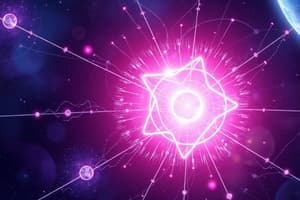Podcast
Questions and Answers
What is the number of electrons in the 2p subshell of a nitrogen atom?
What is the number of electrons in the 2p subshell of a nitrogen atom?
3
What is the correct electron configuration for bromine?
What is the correct electron configuration for bromine?
[Ar]4s2 4p6 4d9
What is ionization energy?
What is ionization energy?
the energy required to remove an electron from an atom
What is electronegativity?
What is electronegativity?
Which are larger, simple cations or the neutral atoms from which they were formed?
Which are larger, simple cations or the neutral atoms from which they were formed?
Fluorine (F) has the smallest atomic radius out of carbon (C), fluorine (F), and magnesium (Mg).
Fluorine (F) has the smallest atomic radius out of carbon (C), fluorine (F), and magnesium (Mg).
Oxygen (O) has the greatest electronegativity out of aluminum (Al), carbon (C), and oxygen (O).
Oxygen (O) has the greatest electronegativity out of aluminum (Al), carbon (C), and oxygen (O).
Which element is the most metallic out of beryllium (Be), calcium (Ca), and strontium (Sr)?
Which element is the most metallic out of beryllium (Be), calcium (Ca), and strontium (Sr)?
Which ion is the largest out of oxide (O-2), sulfide (S2-), and telluride (Te-2)?
Which ion is the largest out of oxide (O-2), sulfide (S2-), and telluride (Te-2)?
Lithium (Li) has the lowest ionization energy out of lithium (Li), nitrogen (N), and neon (Ne).
Lithium (Li) has the lowest ionization energy out of lithium (Li), nitrogen (N), and neon (Ne).
Flashcards are hidden until you start studying
Study Notes
Electron Configuration and Atomic Structure
- The nitrogen atom has three electrons in its 2p subshell, indicating its placement in the periodic table.
- Bromine's correct electron configuration is [Ar]4s²4p⁶4d⁹, showcasing its complex arrangement of electrons.
Key Concepts in Chemistry
- Ionization energy refers to the energy necessary to remove an electron from an isolated atom, impacting how elements react chemically.
- Electronegativity describes the ability of an atom in a molecule to attract shared electrons, affecting bond formation and molecular polarity.
Atomic and Ionic Comparisons
- Simple cations are generally smaller than their respective neutral atoms, due to the loss of electrons leading to reduced electron-electron repulsion.
- Among the elements studied, fluorine exhibits the smallest atomic radius when compared to carbon and magnesium.
Element Characteristics
- Oxygen is noted for having the highest electronegativity in comparison with aluminum and carbon, which influences its reactivity and bonding.
- Strontium is identified as the most metallic element compared to beryllium and calcium, indicating a tendency to lose electrons easily.
Ionic Size
- Tellurium ion (Te²⁻) is the largest in size among the ions of oxygen (O²⁻), sulfur (S²⁻), and itself, highlighting the impact of added electrons on ionic radius.
Ionization Energy Trends
- Lithium has the lowest ionization energy compared to nitrogen and neon, making it more reactive and easier to ionize.
Studying That Suits You
Use AI to generate personalized quizzes and flashcards to suit your learning preferences.




